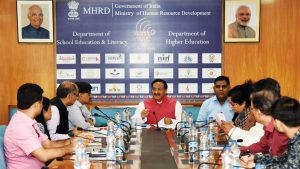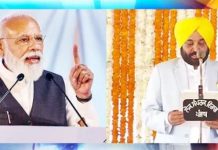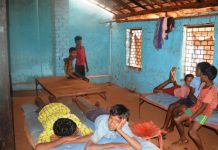 The Draft National Education Policy handed over recently in New Delhi in the presence of R. Subrahmanyam, Secretary Department of Higher Education and Rina Ray, Secretary Department of School Education and Literacy and other senior officials of the Ministry would be a departure from the present system.
The Draft National Education Policy handed over recently in New Delhi in the presence of R. Subrahmanyam, Secretary Department of Higher Education and Rina Ray, Secretary Department of School Education and Literacy and other senior officials of the Ministry would be a departure from the present system.
All Indian children could soon enter the formal education the system at the age of three, with the draft National Education Policy projecting an expansion of the Right To Education Act to cover the three years of preschool before Class 1.
An inter-ministerial task force will work out a roadmap for the transition by the end of 2019, says the draft policy. The draft policy also wants early childhood education to be overseen and regulated by the Ministry of Human Resource Development (HRD) as part of the school system, rather than the private pre-schools and anganwadis that currently cater to the 3-to-6 years age group.
The HRD Ministry is in the early stages of assessing the implications of such a move. Additional costs will come in the form of teacher recruitment and training, infrastructure and learning materials, as well as nutritional aspects (including the proposal to provide breakfast to young children), said Ministry officials.
The Ministry does not yet have accurate data on what percentage of children are neither in pre-schools nor the anganwadi system. Given that the WCD Ministry has been in charge of this for over 40 years, it’s not clear if they would be willing to give it up, said one official.
The draft Policy praises the contribution of anganwadis to improving health and nutrition but notes that their record in education is not so strong.it says that the private pre-schools often consist of formal teaching and rote memorization with limited play-based learning. The draft Policy suggests a new integrated curricular framework for 3 to 8-year olds with a flexible system based on play, activity, and discovery, and beginning exposure to three languages from age 3 onwards. Training and strengthening anganwadi capabilities and linking them to a local primary school, co-locating anganwadis and pre-schools with primary schools would implement this framework or building stand-alone pre-schools also linked to a local primary school.
The Committee led by the Chairman Dr. Kasturirangan submitted the Draft National Educational Policy to the Union Human Resource Development Minister, Ramesh Pokhriyal ‘Nishank’ and Minister of State for HRD, Sanjay Shamrao Dhotre in New Delhi in the presence of R. Subrahmanyam, Secretary Department of Higher Education and Rina Ray, Secretary Department of School Education and Literacy and other senior officials of the Ministry.
The Government of India had initiated the process of formulating a New Education Policy to meet the changing dynamics of the requirements of the population with regard to quality education, innovation and research, aiming to make India a knowledge superpower by equipping its students with the necessary skills and knowledge and to eliminate the shortage of manpower in science, technology, academics, and industry. The extant National Policy on Education, 1986 modified in 1992 required changes to meet the contemporary and futuristic needs of our large youth population.
For this, the MHRD initiated an unprecedented collaborative, multi-stakeholder, multi-pronged, bottom-up people-centric, inclusive, participatory consultation process. The extensive consultations were undertaken across multiple levels of online, expert and thematic, and from the grassroots ranging from Village, Block, Urban Local bodies, District, State, Zonal and the National level, provided an opportunity for every citizen to engage in this massive exercise. Several in-person and in-depth deliberations across a wide spectrum of stakeholders were held. Subsequently, a ‘Committee for Evolution of the New Education Policy’ under the Chairmanship of Late Shri T.S.R. Subramanian, Former Cabinet Secretary, was constituted, which submitted its report in May 2016. Based on this report, the Ministry prepared ‘Some Inputs for the Draft National Education Policy, 2016’.
The Committee had the onerous task of analysing and examining a humungous volume of suggestions, inputs, reports, and outcome documents that preceded its own efforts. The underlying spirit that dictated the Committee’s own course of crafting this significant document was primarily to bring out a vision document which will hold the test of time for at least another 20 years. The Draft National Education Policy, 2019 is built on the foundational pillars of Access, Equity, Quality, Affordability, and Accountability. The Committee has proposed to rename MHRD as Ministry of Education.
In School Education, a major reconfiguration of curricular and pedagogical structure with Early Childhood Care and Education (ECCE) as an integral part of school education is proposed. The Committee also recommends Extension of Right to Education Act 2009 to cover children of ages 3 to 18. A 5+3+3+4 curricular and pedagogical structure based on cognitive and socio-emotional developmental stages of children: Foundational Stage (age 3-8 yrs): 3 years of pre-primary plus Grades 1-2; Preparatory Stage (8-11 years): Grades 3-5; Middle Stage (11-14 years): Grades 6-8; and Secondary Stage (14-18 years): Grades 9-12. Schools will be re-organized into school complexes. It also seeks to reduce the content load in the school education curriculum. There will be no hard separation of learning areas in terms of curricular, co-curricular or extracurricular areas and all subjects, including arts, music, crafts, sports, yoga, community service, etc. will be curricular. It promotes active pedagogy that will focus on the development of core capacities and life skills.
The Committee proposes for massive transformation in Teacher Education by shutting down sub-standard teacher education institutions and moving all teacher preparation/education programmes into large multidisciplinary universities/colleges. The 4-year integrated stage-specific B.Ed. programme will eventually be the minimum degree qualification for teachers.
In higher education, a restructuring of higher education institutions with three types of higher education institutions is proposed- Type 1: Focused on world-class research and high-quality teaching; Type 2: Focused on high-quality teaching across disciplines with significant contribution to research; Type 3: High-quality teaching focused on undergraduate education. This will be driven by two Missions -Mission Nalanda & Mission Takshashila. There will be re-structuring of Undergraduate programs (e.g. BSc, BA, BCom, BVoc) of 3 or 4 years duration and having multiple exits and entry options.
A new apex body Rashtriya Shiksha Ayog is proposed to enable a holistic and integrated implementation of all educational initiatives and programmatic interventions, and to coordinate efforts between the Centre and States. The National Research Foundation, an apex body is proposed for creating a strong research culture and building research capacity across higher education.
The four functions of Standard setting, Funding, Accreditation and Regulation to be separated and conducted by independent bodies: National Higher Education Regulatory Authority as the only regulator for all higher education including professional education; Creation of accreditation eco-system led by revamped NAAC; Professional Standard Setting Bodies for each area of professional education and UGC to transform to Higher Education Grants Commission (HEGC). The private and public institutions will be treated on par and education will remain a ‘not for profit’ activity.
Several new policy initiatives for promoting internationalization of higher education, strengthening quality open and distance learning, technology integration at all levels of education, adult and lifelong learning and initiatives to enhance participation of under-represented groups, and eliminate gender, social category and regional gaps in education outcomes are recommended. Promotion of Indian and Classical Languages and setting up three new National Institutes for Pali, Persian, and Prakrit and an Indian Institute of Translation and Interpretation (IITI) has been recommended.
letters@tehelka.com













